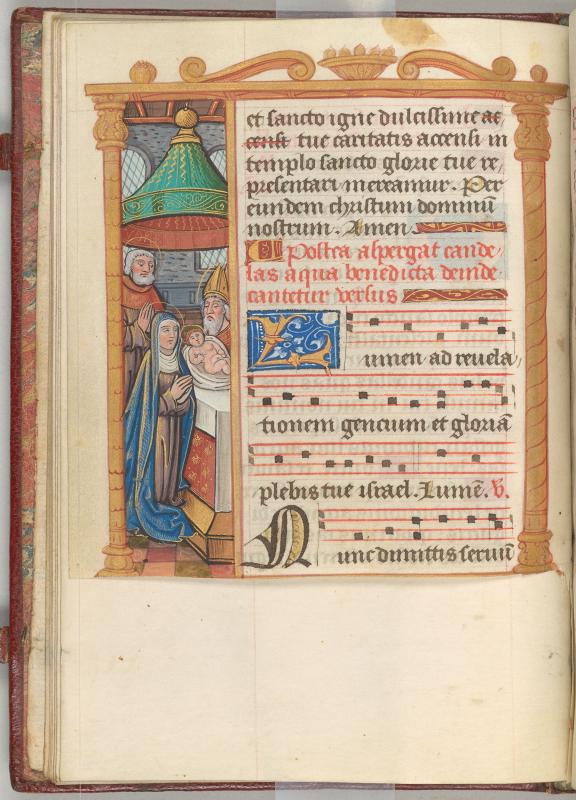
Accession number
MS M.1214
Object title
Processional.
Created
France, Paris, 1505-1515
Binding
18th-century red morocco, gold tooled with panels and corner fleurons, two leather straps with scallop catches in metal (lacking the upper catch-pin).
Credit line
Purchased as the gift of Virginia M. Schirrmeister, member of the Visiting Committee to the Department of Medieval and Renaissance Manuscripts, 2019.
Description
1, ii, 172, ii leaves : vellum and paper (leaf 1), illuminated ; 160 x 110 mm
Provenance
Made for a nun at the Dominican convent of St. Louis de Poissy, ca. 1505-1515; probably taken by the nuns of Poissy when they left the convent, 1790-1792; Abbot Nicolas-Pierre Ythier (1738-1809), dean and canon of the church of Saint-Quiriace in Provins (his bookplate, which is inscribed "No. 16"); Abbot Ythier's niece Mme Colin de Saint-Marc, Coulommiers (her bookplate); bought in 2019.
Notes
Measurements: 160 x 110 (95 x 53) mm; 6 3/8 x 4 3/8 inches
Collation: I (8) II (2) III-XIV (8) XV (6) XVI-XX (8) XXI (2) XXII (8) XXIII (7) XXIV (3)
This small, portable Processional, containing the Latin prayers and music for liturgical processions; made in Paris ca. 1505-15, and illuminated by Jean Coene IV, was commissioned by a Dominican nun at the Royal Abbey of Poissy, founded by Philip the Fair of France (r. 1285-1314) in honor of his grandfather, King Louis IX (canonized in 1297).
Decoration: 10 historiated borders, 8 of which include an image of the nuns of Poissy in procession holding their processionals.
List of illustrations: f. 11v: Presentation in the Temple (lower border excised); f. 26: Entry into Jerusalem (lower border excised); f. 113: Resurrection and nuns of Poissy in procession; f. 115v: Ascension and nuns of Poissy in procession; f. 119v: Two Angels Holding the Eucharist in a Monstrance and nuns of Poissy in procession; f. 123v: St. John the Baptist and nuns of Poissy in procession; f. 127v: St. Dominic and nuns of Poissy in procession; f. 131: Assumption of the Virgin and nuns of Poissy in procession; f. 135v: St. Louis and nuns of Poissy in procession; f. 140: Nativity of the Virgin and nuns of Poissy in procession.
Artist: Jean Coene IV (Master of the Paris Entries)
Collation: I (8) II (2) III-XIV (8) XV (6) XVI-XX (8) XXI (2) XXII (8) XXIII (7) XXIV (3)
This small, portable Processional, containing the Latin prayers and music for liturgical processions; made in Paris ca. 1505-15, and illuminated by Jean Coene IV, was commissioned by a Dominican nun at the Royal Abbey of Poissy, founded by Philip the Fair of France (r. 1285-1314) in honor of his grandfather, King Louis IX (canonized in 1297).
Decoration: 10 historiated borders, 8 of which include an image of the nuns of Poissy in procession holding their processionals.
List of illustrations: f. 11v: Presentation in the Temple (lower border excised); f. 26: Entry into Jerusalem (lower border excised); f. 113: Resurrection and nuns of Poissy in procession; f. 115v: Ascension and nuns of Poissy in procession; f. 119v: Two Angels Holding the Eucharist in a Monstrance and nuns of Poissy in procession; f. 123v: St. John the Baptist and nuns of Poissy in procession; f. 127v: St. Dominic and nuns of Poissy in procession; f. 131: Assumption of the Virgin and nuns of Poissy in procession; f. 135v: St. Louis and nuns of Poissy in procession; f. 140: Nativity of the Virgin and nuns of Poissy in procession.
Artist: Jean Coene IV (Master of the Paris Entries)
Contents
ff. 1-10: Preliminary chants and prayers for Masses against plague (1-5), of St. Vincent (5-7), of St. Dominic (7-9), and of St. Sebastian (9-10); ff. 11-16: Processional Office for the Purification of the Virgin (February 2); ff. 16v-24: Processional Office for Ash Wednesday; ff. 24-35v: Processional Office for Palm Sunday; ff. 35v-38: Kyrie for Wednesday of Holy Week; ff. 38-63v: Processional Office for Maundy Thursday, which includes the ceremonies for cleansing the altars of St. Louis (39-41), the Trinity (41-43), the Assumption of the Virgin (43-45), Sts. Augustine and Thomas (45-46v), Sts. Maur and Anthony (46v-49), St. Martin (49-50v), St. Stephen (50v-52), Angels (52-54), St. Denis (54-55), Sts. Peter and Paul (55-55v), St. Blaise (55v-56v), Sts. Loup and Giles (56v-57), Sts. Dominic and Peter Martyr (57-58), Sts. Sebastian and Yves (58-58v), the Annunciation (58v-59v), St. John the Baptist (59v-60), Sts. John and James (60-60v), St. Catherine (60v-61v), Sts. Mary Magdalene and Martha (61v-63), and St. Anne (63-63v); ff. 63v-72v: Mandatum (foot washing) on Maundy Thursday; ff. 72v-86v: Gospel reading from John followed by sermons for Maundy Thursday; ff. 86v-88v: Vespers for Maundy Thursday; ff. 88v-102v: Readings and Tracts for Good Friday; ff. 102v-112v: Adoration of the Cross on Good Friday; ff. 113-115v: Processional Office for Easter and the following two days; ff. 115v-119v: Processional Office for the Ascension; ff. 119v-123v: Processional Office for Corpus Christi; ff. 123v-127v: Processional Office for St. John the Baptist; ff. 127v-131: Processional Office for St. Dominic; ff. 131-135v: Processional Office for the Assumption of the Virgin; ff. 135v-140: Processional Office for St. Louis; ff. 140-143v: Processional Office for the Nativity of the Virgin; ff. 143v-145: Processional Office for the reception of legates; ff. 145-147v: Processional Office for the reception of secular princes; ff. 147v-152: Hymns and prayers for the reception of a novitiate; ff. 152v-162: Prayers before Communion; ff. 162-169v: Prayers after Communion; ff. 170-172: Processional Office for the Blessed Sacrament (added in the late 16th century).
Script
Gothic book-hand (textualis quadrata)
Language
Latin
Catalog link
Classification
Department
